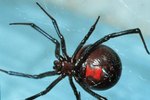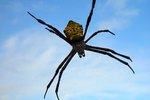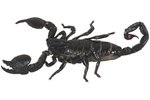
Although many people consider spiders to be scary, some species are unique and beautiful. Ecuador is home to a number of tarantula types, some of which are commonly kept as pets by spider enthusiasts, and others that are not at all docile, even in the wild.
Avicularia Purpurea
Also called the purple pinktoe, the Avicularia purpurea is a distinctive tarantula found in Ecuador. Though it looks black, under bright lights its coloration becomes a stunning deep purple. Though non-aggressive, the purple pinktoe is very skittish and moves quite fast. Adults reach sizes of up to 4.5 inches, and females may live to be 12 years old, compared to the male average of only 3 years. These spiders live and hunt off of the ground in trees, feeding on insects like flies, crickets, cockroaches and moths, and even occasionally small rodents.
Pamphobeteus Insignis
Sometimes called the Columbian purple bloom, male tarantulas of this species also have purple coloration throughout the body and legs. Females range in color from an olive brown to a reddish brown, depending on the stage of life. The body hair is short, and although these spiders are typically docile, they have a habit of flicking hairs at predators. The average size for adults is about 7.5 inches, but some records of 8.5-inch Pamphobeteus insignis have been documented. They spend the majority of their lives in ground level burrows, feeding on crickets, roaches, small lizards and mice.
Theraphosa Blondi
The largest species of tarantula is also called the goliath bird-eating spider, and its leg span can reach up to 12 inches. They are burrowers and spend the majority of their lives inside their homes, never moving more than a few feet away even while hunting. They prefer swampy areas near water, where their brown bodies will blend into the surroundings. Considered extremely aggressive, these spiders do not make good pets, and are prone to biting -- their 1-inch fangs can do a great deal of damage, although the venom is not fatal to humans. The typical diet of this spider includes amphibians, rodents, insects, snakes and the occasional small bird.
Megaphobema Velvetosoma
Known as the Ecuadorian brown velvet spider, this spider grows to about 7.5 inches. Their brown/black coloration and bodies covered with short hair give them both their name and the ability to successfully thrive within their habitat. Spending most of their time on the rainforest floor, the Megaphobema velvetosoma aggressively hunts its prey, which includes crickets, worms and cockroaches. The spider is not recommended for beginner owners, as the behavior they exhibit in the wild should be expected in captivity, too. They move quickly, and have long lifespans -- some of these spiders can live to be 15 years old.
References
- Big Hairy Spiders (Phong's Tarantulas!): Ecuadorian Purple (Avicularia purpurea)
- Jamie's Tarantulas: Avicularia purpurea
- Amazing Tarantulas: Species LAS-THE
- Tarantula Spiders: Pamphobeteus insignis
- Tarantulas.com: Xenesthis immanis
- Blue Planet Biomes: Goliath Bird Eating Spider
- Exotic Animals: megaphobema velvetosoma
Photo Credits
-
John Foxx/Stockbyte/Getty Images




